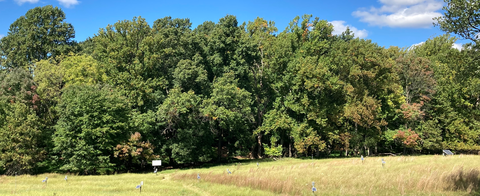Summary
The NIST Headquarters in Gaithersburg, MD also provides a convenient testbed to evaluate the current state of knowledge relating optical remote sensing to biophysiological measurements of vegetative land cover. The mixed deciduous forest at NIST, with some tree specimens well over 100 years old, has a network of sensors deployed over a 1-hectare area within the larger 40-hectare forest. These sensors measure respiration, sap flow in trees, and meteorological parameters to provide ground truth to model simulations and optical observations. Optical observations provide the advantage of sampling up to the global scale. However, linking a satellite scale footprint to leaf-level observations is an ongoing area of research. The testbed serves as a reference and a link to SI-traceable standards for the support of industry developing the next generation of sensors (ranging from ground-based to space-based).
Description

The goals of the research are to:
- Provide a testbed (Forested Optical Reference for Evaluating Sensor Technology, FOREST) for ecophysiological and optical sensors with well-established reference points
- Quantify ecosystem phenomenology that will allow for better estimates of productivity
- Link leaf level to satellite footprint scale observations
- Facilitate traceability to NIST standards (from ground-based, Unmanned Aerial Vehicles (UAVs), to satellite)
Selected Publications
- Jones, T.S., Logan, B.A., Reblin, J.S., Bombard, D.M., Ross, B.P., Allen, D.W., Marrs, J.K., Hutyra, L.R., in submission. Stress-induced Changes in Photosynthesis and Proximal Fluorescence Emission of Turfgrass. Geophysical Research Letters.
- Jones, T.S., Winbourne, J.B., Hutyra, L.R., 2020. Ribbonized sap flow: an emerging technology for the integration of sap flow sensor components onto a single platform. Ecosphere 11, 1–15. https://doi.org/10.1002/ecs2.3135
- Marrs, J.K., Hutyra, L.R., Allen, D.W., 2019. Solar-induced fluorescence retrievals in the context of physiological, environmental, and hardware-based sources of uncertainty, in: Proceedings of SPIE 10986, Algorithms, Technologies, and Applications for Multispectral and Hyperspectral Imagery XXV. pp. 1–14. https://doi.org/10.1117/12.2520457
- Marrs, J.K., Jones, T.S., Allen, D.W., Hutyra, L.R., 2021. Instrumentation sensitivities for tower-based solar-induced fluorescence measurements. Remote Sensing of Environment 259, 112413. https://doi.org/10.1016/j.rse.2021.112413
- Marrs, J.K., Jones, T.S., Logan, B.A., Reblin, J.S., Maguire, A.J., Winbourne, J.B., Bromley, F.L., Nelson, S., Allen, D.W., Hutyra, L.R., in revision. Drivers of variability in solar-induced fluorescence and leaf-level energy partitioning across temporal scales. Remote Sensing of Environment.
- Marrs, J.K., Reblin, J.S., Logan, B.A., Allen, D.W., Reinmann, A.B., Bombard, D.M., Tabachnik, D., Hutyra, L.R., 2020. Solar-induced fluorescence does not track photosynthetic carbon assimilation following induced stomatal closure. Geophysical Research Letters 47, 1–11. https://doi.org/10.1029/2020GL087956
- Smith, I.A., Hutyra, L.R., Reinmann, A.B., Thompson, J.R., Allen, D.W., 2019. Evidence for Edge Enhancements of Soil Respiration in Temperate Forests. Geophysical Research Letters 46, 4278–4287. https://doi.org/10.1029/2019GL082459
- Winbourne, J.B., Smith, I.A., Stoynova, H., Kohler, C., Gately, C.K., Logan, B.A., Reblin, J., Reinmann, A., Allen, D.W., Hutyra, L.R., 2022. Quantification of Urban Forest and Grassland Carbon Fluxes Using Field Measurements and a Satellite‐Based Model in Washington DC/Baltimore Area. JGR Biogeosciences 127. https://doi.org/10.1029/2021JG006568

